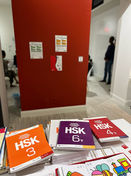GCSE Mandarin Chinese Test Structure
Please scroll down for the layout of Edexcel GCSE Mandarin Chinese tests.
If you are seeking extra Mandarin tutoring support, please book a free trial lesson with one of our GCSE Mandarin Chinese tutors, or sign up for our GCSE Mandarin Chinese classes and mock exam sessions in London.
Beginning in 2024, we will be running Easter break GCSE Chinese test-prep immersive China trips!

There are different exam boards that offer Mandarin GCSE tests, and the types of tests they offer may vary slightly. However, in general, there are two types of Mandarin GCSE tests:
-
Chinese as a Foreign Language (CFL) GCSE (Foundation Tier): This type of GCSE is designed for non-native speakers of Mandarin Chinese. It assesses the student's ability to understand and communicate in Mandarin Chinese, as well as their knowledge of Chinese culture and society.
-
Chinese as a Second Language (CSL) GCSE (Higher Tier): This type of GCSE is designed for students who have a native or near-native proficiency in Mandarin Chinese. It assesses the student's ability to use the language in a variety of situations, and to understand and analyze different types of texts.
Within each type of GCSE, there may be variations in the exam structure and content, depending on the exam board. For example, some exam boards may include more cultural or historical content, while others may focus more on contemporary issues and current events. It's important to check the specific requirements of the exam board you are studying with in order to prepare effectively for the test.
Pearson Edexcel GCSE Chinese Test Structure
The Pearson Edexcel Level 1/Level 2 GCSE (9–1) in Chinese (spoken Mandarin/spoken Cantonese) consists of four externally examined papers based on the following skills: listening, speaking, reading and writing. Students must complete their speaking assessment in April/May and all other assessments in May/June in any single year. Each paper is available at Foundation tier or Higher tier. Students must be entered for a single tier across all papers. The use of dictionaries is not permitted. For Paper 2 this includes during the preparation time.
Paper 1: Listening and understanding in Chinese
Foundation tier: 35 minutes, including 5 minutes’ reading time; 50 marks
Higher tier: 45 minutes, including 5 minutes’ reading time; 50 marks
25% of the total qualification
Assessment overview
Students are assessed on their understanding of standard spoken Chinese by one or more speakers in a range of public and social settings. Students will respond to multiple-response and short-answer open-response questions based on a recording featuring male and female Chinese speakers. Students must answer all questions in both sections. There is no requirement for students to produce written responses in Chinese.
Foundation tier: All questions are set in English. The instructions to students are in English.
Higher tier: All questions are set in English. The instructions to students are in English. The listening audio files are available on our website. Recordings of spoken Chinese will be available in Mandarin and Cantonese.
Paper 2: Speaking in Chinese
Foundation tier: 7–9 minutes plus 12 minutes’ preparation time; 70 marks
Higher tier: 10–12 minutes plus 12 minutes’ preparation time; 70 marks
25% of the total qualification
Assessment overview
Students are assessed on their ability to communicate and interact effectively through speaking in Chinese for different purposes and in different settings.
There are three tasks which must be conducted in the following order:
● Task 1 – a role play based on one topic that is allocated by Pearson
● Task 2 – questions based on a picture stimulus based on one topic that is allocated by Pearson
● Task 3 – conversation based on two themes.
The first theme is based on the topic chosen by the student in advance of the assessment. The second theme is allocated by Pearson. The assessment will be available in Mandarin and Cantonese. The assessments are conducted by teachers in one session within a prescribed assessment window, the recordings are then submitted to Pearson for external marking.
Paper 3: Reading and understanding in Chinese
Foundation tier: 50 minutes; 50 marks.
Higher tier: 1 hour 5 minutes; 50 marks
25% of the total qualification
Assessment overview
Students are assessed on their understanding of written Chinese across a range of different types of texts, including advertisements, emails, letters, articles and literary texts. Students are required to respond to multiple-response and short-answer questions based on these texts.
Students must answer all questions in each of the two sections:
● Section A is set in English. The instructions to students are in English.
● Section B includes a translation passage from Chinese into English with instructions in English.
The assessment will be available in traditional and simplified characters. All questions and texts are printed twice, once with texts using traditional/full characters and once with texts in simplified characters.
Paper 4: Writing in Chinese
Foundation tier: 1 hour 20 minutes; 60 marks
Higher tier: 1 hour 25 minutes; 60 marks
25% of the total qualification
Assessment overview
Students are assessed on their ability to communicate effectively through writing in Chinese for different purposes and audiences. Students are required to produce responses of varying lengths and types to express ideas and opinions in Chinese. The instructions to students are in English. Character counts are specified for each question. Students must answer all questions.
Foundation tier: There are three open-response questions and one translation into Chinese.
Higher tier: There are two open-response questions and one translation into Chinese. Students can complete the assessment using either traditional or simplified characters. All questions are printed twice, once for students opting to write using traditional/full characters and once for students opting to write using simplified characters.










